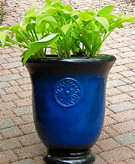Hosta Virus X is a contagious and disfiguring disease of hostas. It is spread through sap of an infected plant coming into contact with the sap of another plant. For hostas in our gardens, this infection can be spread by common gardening techniques, such as by pruning or transplanting or dividing hosta clumps with tools that have been previously used on infected plants without proper cleaning between uses. The virus seems to be specific to hosta species and cultivars, and has probably been around for a long time. But the wide practice of tissue culture micropropagation of hostas beginning about 20 years ago (which allows you to buy a $3 hosta plant at the Big Box nursery department) may have spread it more widely before the plants became symptomatic. Now it is widely recognized as a problem and most growers take care to provide virus-free plants. However, like hosts for a lot of viruses, the infected plants can be asymptomatic for years before showing the classic symptoms of leaf mottling with an "ink-bleed" pattern emanating from the leaf veins.
What can you do about it? - Fortunately, it is now possible to diagnose the infection in hosta plants even when they are asymptomatic, with a simple to use dip-stick test. But these tests are $5-10 each, so practically they are for the growers who do their best to provide virus-free plants. The home gardener is probably money ahead to discard a plant they think may be infected (due to symptoms), and replace it with a new inexpensive variety. The virus can live on in bits of the infected plant that remain in the soil, so it is best to not plant a new hosta into the place where an infected one was removed. Choose a different species of plant in that spot, or add a big garden boulder there. Garden hygiene is absolutely critical if you have a number of hostas in your garden, so that you don't spread the virus between your plants. All it takes is to get one infected but asymptomatic plant, and spread the disease by using infected pruners, shears, shovels, hoes or other garden implements.
General hygiene when working with your hostas. If you have a symptomatic hosta (see many available photos online), you should remove it from your garden. Using disposable rubber gloves, cut off all the stems and leaves of the infected plant, being careful to not get sap on any other hostas nearby. You may want to protect nearby hostas with shields made from cardboard boxes or garbage bags. Dispose of all the plant rubbish in the trash, not on your compost pile. Then put a cover over the cut back clump to prevent new shoots from developing that year. Then wait until autumn, when the virus is less infective, to dig up the plant and dispose of the entire rootball in the regular trash. Alternatively, you could totally cover the infected plant with a black plastic trash bag and kill the plant over the summer, and then dig it out in autumn. Or you could use a plant killer like RoundUp brand herbicide to kill the infected plant. Just be sure to not spray your good plants. But, glyphosate is not really that effective at killing hostas. You must clean your garden tools thoroughly between each plant that you work on. I have multiple shovels, trowels and dividing knives available so that the used ones are put into a detergent solution for scrubbing, and then into a bleach solution for sterilizing between uses. With several of each, I can be very productive by washing a bunch of tools at once, and then using sanitized tools on each plant, whether infected or not.
